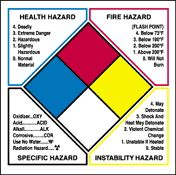 |
 |
| MSDS Topics |
Free Sites | FAQ's | Regulations | Glossary | Software | Suppliers |
| Books | Forum | Poll | Fun stuff | Quiz | Store | |
| MSDS and safety supplies | Search ALL our MSDS info | |||||
 | |||
 |
 |
 |
|
| Title: 10/06/1994 - Labelling, training and material safety data sheet and the Hazard Communication standard. | |
| Record Type: Interpretation | Standard Number: 1910.1027; 1910.1200 |
October 6, 1994
Richard F. Boggs, Ph.D.
Vice President
Organization Resources Counselors,Inc.
1910 Sunderland Place, N.W.
Washington, D.C. 20036
Dear Dr. Boggs:
This is in response to your letters of July 28, 1993, and May 10, concerning the labelling, training and material safety data sheet (MSDS) requirements of the Cadmium standard, 29 CFR 1910.1027, and the Hazard Communication standard (HCS), 29 CFR 1910.1200, as each would apply to cadmium-coated or cadmium-plated fasteners. We apologize for the long delay in our response to your first letter.
|
In your first letter you inquired if labelling, MSDS or training would be required under the Cadmium standard or the HCS, where the potential source of exposure is cadmium coated fasteners. More specifically, you wanted to know how the particular provisions under either standard would apply to the following conditions, (1) airborne cadmium exposure is less than the limit of detection where the limit of detection is below 10% of the PEL and (2) where airborne cadmium exposure is detectable but less than the action level. You also asked if the standard would apply if cadmium dust was or was not visible in containers or on gloves or hands of employees. In the May 10 letter, you made an additional inquiry related to the requirements of the cadmium standard. You asked if the requirements to label installed cadmium containing products apply to appliances such as washing machines or vehicles which contain metal parts joined with cadmium plated fasteners or with cadmium coated fasteners? As you may know, the Cadmium standard applies to all occupational exposures to cadmium and cadmium compounds. Further, paragraph 1910.1027(m) specifies the requirement for communication of cadmium hazards to employees including referencing the Hazard Communication (HCS) standard. |  Ensure that your MSDS collection is "readily accessible" with these handy compliance centers from Safety Emporium.
|
Under the HCS, employers are required to provide information to their employees about the hazardous chemicals which are known to be present in the workplace in such a manner that employees may be exposed under normal conditions of use or in a foreseeable emergency. Exposure is defined to include both possible and accidental exposure.
The HCS addresses chemical hazards which are inherent properties of the hazardous chemical and would exist no matter what quantity was present in the workplace. Risk is a function of the inherent hazard and level of exposure. A substance either is or is not a hazardous chemical; the HCS definition cannot be read to indicate that a substance could be a hazardous chemical in some concentrations but not in others.
The HCS and therefore the Cadmium standard requirements for training, MSDS, and labels would apply to the conditions presented in your first letter, unless the manufacturer or importer of the fasteners have claimed an "article" exemption. An article is defined in paragraph (c) of the HCS as:
 Communicate workplace hazards with handy labels from Safety Emporium. |
You stated that the amount of cadmium is less than the 0.1% of the HCS's threshold level for mixtures not tested as a whole (refer to 1910.1200(d)(5)(iii)). OSHA does not believe that the mixture (0.1%) trigger level is relevant in this case. The mechanical coating or plating of cadmium to the fasteners does not combine to form a mixture. The cadmium adheres to the outer surface layer of the fastener. Consequently, the weight of cadmium coating in relation to the total weight of the fasteners is unrelated to what is released and available for employee exposure. However, the percentage of cadmium in the coating material alone would be relevant to the 0.1% trigger level and therefore, employee exposure. You questioned whether the HCS applies when cadmium dust is visible in a container or on the worker. Application of the HCS is not based on whether the hazardous chemical is visible. It applies whenever cadmium is known to be present in the workplace. The absence or presence of visible cadmium dust would be important information in terms of personal protective equipment and hygiene practices. In response to the questions contained in your second letter. Paragraph 1910.1027(m)(3)(iii) is a performance requirement that states: "Where feasible, installed cadmium products shall have a visible label or other indication that cadmium is present. Consequently, some form of identification, such as a label, would be required for the installed cadmium containing fasteners. |
Thank you for your inquiry regarding compliance with the Cadmium standard.
Sincerely,
John B. Miles, Jr., Director
Directorate of Compliance Programs
The official, public domain, OSHA version of this document is available at http://www.osha.gov/pls/oshaweb/owadisp.show_document?p_table=INTERPRETATIONS&p_id=21609&p_text_version=FALSE